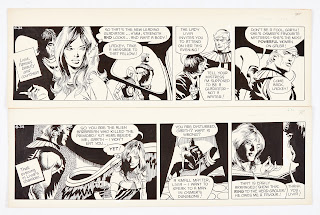 |
| Used by permission of Alan Davis |
 |
| Used by permission of Alan Davis |
 |
| Used by permission of Alan Davis |
Alan Davis (in his Unknown Bellamy section of his website) shows three images next to each other (numbers 6-8 as I have labelled them here). I can reveal they are actually advertising for a cine-camera as you might guess.
 |
| Movie Maker June 1967 cover |
Movie Maker - note the two separate words (unlike MovieMaker in the USA) was a magazine that began as a new title in March 1967 (and ran till October 1985) and was published by Fountain Press Limited, publishers of many books on photography too. I confess I have only ever seen the one I own - June 1967 - and you know why I have that issue in particular! The cover shows a woman - hardly visible, ironically - behind a film projector and the magazine cost 3/6d.
The title began life through the incorporation of Amateur Cine World, 8mm Movie Maker and Cine Camera. The British Library states it also incorporated Film Making as well, but that's not in the one I own, and they say its later title was Making Better Movies. This glossy black and white magazine is 28 x 20.5cm and was published on the second Thursday of the month "preceding the month for which it is dated"- well, in June 1967 anyway! The Editor was Tony Rose, the Assistant Editor Alan Cleave and the Art Editor Anthony-Brian Grant. The Advertising Manager was John Patrick. It contains loads of advertising but also "How-to-do-it" features, Special Features, News and Reviews- one of which is by Denis Gifford: "Films to Buy"! Gifford commissioned Frank Bellamy for his comic Ally Sloper, which became Bellamy's last comic strip ever in 1976, so is too far-fetched to assume he put a word in for Bellamy? Or maybe it all went through an agency and is just coincidence!
Anyway our focus today is on Bell and Howell's "The Optronic Eye: Report on the Bell and Howell Optronic Eye Super 8 camera in action" which appears over three right-hand pages (which any advertising person will tell you costs more than any left-hand page) - p309, 311, 313.
The first thing I notice in Alan Davis' rescued Polaroid (see top of article) is the lettering is surprisingly not by Frank Bellamy but added later. However it seems obvious Bellamy left space in the designs for boxes containing text.
 |
| Movie Maker June 1967 p.309 |
The first page introduces us to this simpler Super 8 camera with cartridge loading capability. I felt the way the guy is holding the device in the first panel looked awkward but this is demonstrated properly by the lady on the instruction manual below
The script is a bit stilted in order to show off all the features and our protagonist uses phrases like ""I don't tolerate mistakes, I gritted" and ""Nix", I grunted"!
 |
| Movie Maker June 1967 p.311 |
The second page ignores "Uncle Arthur" and moves to the father of the bride who obviously knows how to do it properly but is outdated. I'd love to know who the model for this was, as he looks like a politician to me, but I suspect he can't be. The last panel is empty of text.
 |
| Movie Maker June 1967 p.313 |
The last page has Bell and Howell's technical sheet for three versions of the camera at £49.19.0, £79.15.0 and lastly £125.0.0 The advert states the camera was developed as a result of "cooperation with official U.S. Government Moon-shot experiments" - whatever that means. The Bell & Howell Research Center in Pasadena certainly looked at spectroscopy at this time. I like the line on this page that seems to thing we are, I presume, secret agents: "Further Classified Information: All agents to memorise"!
Unfortunately, despite having access to the Bellamy's financial accounts for the period (for which I'm ever grateful to Nancy Bellamy) I can't find anything attributed to the brand or any agency that can be identified.
So we can tick off those three images now!
NEXT: Unknown Bellamy # 9 - that comic strip.





















